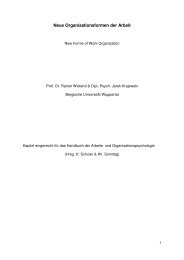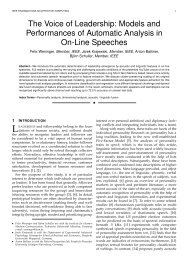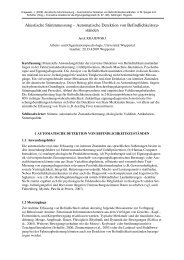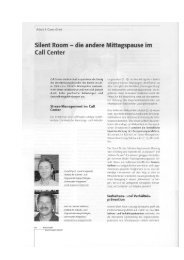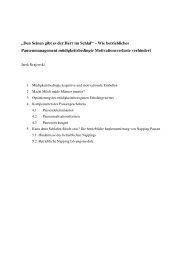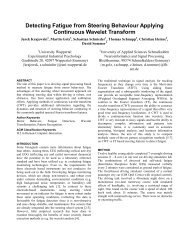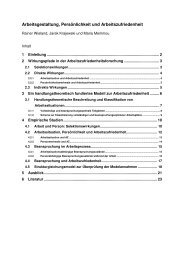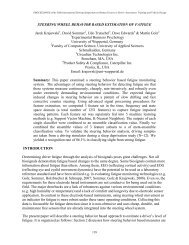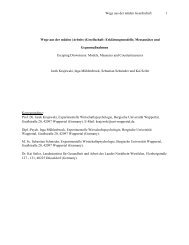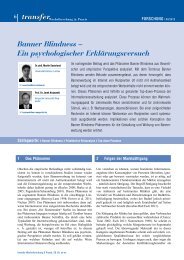Somnologie - Prof. Dr. Jarek Krajewski
Somnologie - Prof. Dr. Jarek Krajewski
Somnologie - Prof. Dr. Jarek Krajewski
Sie wollen auch ein ePaper? Erhöhen Sie die Reichweite Ihrer Titel.
YUMPU macht aus Druck-PDFs automatisch weboptimierte ePaper, die Google liebt.
den 5–10 Rater zur Bestimmung der<br />
„ground truth“ genutzt) und<br />
F einen prototypbasierten Ansatz (Vorselektion<br />
der Fälle mit Konkordanz<br />
aller Validierungsinstrumente) erzielt<br />
werden.<br />
Vor dem Hintergrund der genannten Einschränkungen<br />
müssen die Validierungsergebnisse<br />
als vorläufig interpretiert werden.<br />
Replikationen mit umfangreichen<br />
und diversifizierten Probandenkollektiven<br />
sind wichtig, um die für einen breiten<br />
Einsatz notwendige Evidenzgrundlage<br />
aufzubauen. Zudem sollten zukünftige<br />
Forschungsbemühungen die Weiterentwicklung<br />
der phonetisch-akustischen<br />
Schläfrigkeitsanalyse insbesondere<br />
über die Anwendung diverser Mustererkennungs-<br />
und Machine-Learning-Verfahren<br />
(„support vector machine“) sowie<br />
über eine geschlechtsspezifische Modellierung<br />
angehen.<br />
Fazit für die Praxis<br />
F Die anwendungspraktische Bedeutung<br />
des vorgestellten Verfahrens<br />
liegt darin, dass für moderate Nebengeräuschbedingungen<br />
eine Messung<br />
von Schläfrigkeit insbesondere im<br />
mittleren und starken Schläfrigkeitsbereich<br />
umgesetzt werden kann.<br />
F Diese Messung kann bislang jedoch<br />
nur als Fit-for-Duty-Testsituation realisiert<br />
werden.<br />
Korrespondenzadresse<br />
<strong>Prof</strong>. <strong>Dr</strong>. J. <strong>Krajewski</strong><br />
Experimentelle Wirtschaftspsychologie,<br />
Universität Wuppertal<br />
Gaußstraße 20, 42097 Wuppertal<br />
Deutschland<br />
krajewsk@uni-wuppertal.de<br />
Interessenkonflikt. Der korrespondierende Autor<br />
gibt an, dass kein Interessenkonflikt besteht.<br />
Literatur<br />
1. Batliner A, Steidl S, Schuller B et al (2011) Whodunnit<br />
– searching for the most important feature<br />
types signalling emotion-related user states in<br />
speech. Computer Speech Language 25:4–28 (in<br />
press)<br />
2. Batliner A, Steidl S, Nöth E (2008) Releasing a thoroughly<br />
annotated and processed spontaneous<br />
emotional database: The FAU Aibo Emotion Corpus.<br />
In: Devillers L, Martin J-C, Cowie R et al. (eds)<br />
Proc. of a satellite workshop of LREC 2008 on corpora<br />
for research on emotion and affect (Workshop<br />
on Corpora for Research on Emotion and Affect<br />
Marrakesh 26.5.2008). LREC 2008, Marrakesh,<br />
pp 28–31<br />
3. Batliner A, Steidl S, Schuller B et al (2006) Combining<br />
efforts for improving automatic classification<br />
of emotional user states. In: Erjavec T, Gros JZ<br />
(Hrsg) Language technologies, IS-LTC 2006. Infornacijska<br />
<strong>Dr</strong>uzba, Ljubljana, Slovenia, S 240–245<br />
4. Batliner A, Seppi D, Steidl S, Schuller B (2010) On<br />
the impact of childrens emotional speech on<br />
acoustic and language models. EURASIP J Audio<br />
Speech Music Process, doi:10.1155/2010/783954<br />
5. Boersma P (2001) PRAAT, a system for doing phonetics<br />
by computer. Glot Int 5:341–345<br />
6. Davidson PR, Jones RD, Peiris MT (2007) EEG-based<br />
behavioral microsleep detection with high temporal<br />
resolution. IEEE Trans Biomed Eng 54:832–839<br />
7. Dittrich E, Brandenburg S, Thüring M (2009) Beobachtungsbasierte<br />
Erfassung von Müdigkeit im Kfz<br />
– die TUBS-Skala. In: Lichtenstein A, Stößel C, Clemens<br />
C (Hrsg) Der Mensch im Mittelpunkt technischer<br />
Systeme. 8. Berliner Werkstatt Mensch-Maschine-Systeme.<br />
VDI, Düsseldorf, S 123–128<br />
8. Hammarberg B, Fritzell B, Gauffin J et al (1980) Perceptual<br />
and acoustic correlates of abnormal voice<br />
qualities. Acta Otolaryngol 90:441–451<br />
9. Haslam DR (1981) The military performance of soldiers<br />
in continuous operations. In: Johnson LC, Tepas<br />
DI, Colquhoun WP, Colligan MJ (Hrsg) Biological<br />
rhythms, sleep and shift work. SP Medical &<br />
Scientific Books, New York, S 217–230<br />
10. Harrison Y, Horne JA (1997) Sleep deprivation affects<br />
speech. J Sleep 20:871–877<br />
11. Heinze C, Trutschel U, Schnupp T et al (2009) Operator<br />
fatigue estimation using heart rate measures.<br />
World Congress on Medical Physics and Biomedical<br />
Engineering, IFMBE Proceeding 25(9):930–934<br />
12. Ingre M, Åkerstedt T, Peters B et al (2006) Subjective<br />
sleepiness, simulated driving performance and<br />
blink duration: Examining individual differences. J<br />
Sleep Res 15:47–53<br />
13. Kienast M, Sendlmeier WF (2000) Acoustical analysis<br />
of spectral and temporal changes in emotional<br />
speech. In: Sendlmeier W (Hrsg) Speech and<br />
signals: Aspects of speech synthesis and automatic<br />
speech recognition: Forum phoneticum. Hector,<br />
Frankfurt a. M., S 157–168<br />
14. <strong>Krajewski</strong> J (2008) Acoustic sleepiness analysis.<br />
PhD thesis. University of Wuppertal, Wuppertal<br />
15. <strong>Krajewski</strong> J, Kröger B (2007) Using prosodic and<br />
spectral characteristics for sleepiness detection. In:<br />
Hamme H van, Son R van (Hrsg) Interspeech proceedings.<br />
University Antwerp, Antwerp, S 1841–<br />
1844<br />
16. <strong>Krajewski</strong> J, Sommer D, Trutschel U et al (2009)<br />
Steering wheel behavior based estimating of fatigue.<br />
Proc Int <strong>Dr</strong>iv Symp Hum Factors <strong>Dr</strong>iv Assess<br />
Train Veh Des 4:118–124<br />
17. Laver J (1980) The phonetic description of voice<br />
quality. Cambridge University, Cambridge, England<br />
18. Levelt WJM, Roelfs A, Meyer AS (1999) A theory of<br />
lexical access in speech production. J Behav Brain<br />
Sci 22:1–75<br />
19. Lewis D, Yang Y, Rose T, Li F (2004) RCV1: A new<br />
benchmark collection for text categorization research.<br />
J Mach Learn Res 5:361–397<br />
20. Muttray A, Weirich O, Du Prel JB et al (2009) Beurteilung<br />
von Fahrerschläfrigkeit von Berufskraftfahrern<br />
mittels Videoanalyse. Arbeitsmed Sozialmed<br />
Umweltmed 44:114<br />
21. Podszus T (2007) Atmung. In: Peter H, Penzel T,<br />
Peter JH (Hrsg) Enzyklopädie der Schlafmedizin.<br />
Springer, Heidelberg, S 80–85<br />
22. Rabiner C, Schafer R (1978) Digital processing of<br />
speech signals. Prentice-Hall International, Inc.<br />
Englewood Cliffs, New Jersey<br />
23. Scherer KR (1974) Acoustic concomitants of emotional<br />
dimensions: Judging affect from synthesized<br />
tone sequences. In: Weitz S (Hrsg) Nonverbal<br />
communication. Oxford University, New York, S<br />
249–253<br />
24. Schnupp T, Schenka A, Edwards D et al (2009) Is<br />
posturography a candidate for a vigilance test?<br />
World Congress on Medical Physics and Biomedical<br />
Engineering, IFMBE Proc 25(9):388–392<br />
25. Schuller B, Wimmer M, Mösenlechner L et al (2008)<br />
Brute-forcing hierarchical functionals for paralinguistics:<br />
A waste of feature space? Proc IEEE Int<br />
Conf Acoust Speech Signal Process 33:4501–4504<br />
26. Sommer D, Golz M, <strong>Krajewski</strong> J (2008) Consecutive<br />
detection of driver’s microsleep events. In: Vander<br />
Sloten J, Verdonck P, Nyssen M, Haueisen J (Hrsg)<br />
IFMBE Proceedings 22. Springer, Berlin, S 243–247<br />
27. Vlasenko B, Schuller B, Wendemuth A, Rigoll G<br />
(2007) Combining frame and turnlevel information<br />
for robust recognition of emotions within speech.<br />
Proc Interspeech 8:2249–2252<br />
28. Vollrath M (1993) Mikropausen im Sprechen. Apparative<br />
Registrierung und psychologische Bedeutung.<br />
Peter Lang, Frankfurt<br />
29. Whitmore J, Fisher S (1996) Speech during sustained<br />
operations. Speech Commun 20:55–70<br />
30. Wilhelm B, Giedke H, Lüdtke H et al (2001) Daytime<br />
variations in central nervous system activation<br />
measured by a pupillographic sleepiness test. J<br />
Sleep Res 10:1–7<br />
<strong>Somnologie</strong> - Schlafforschung und Schlafmedizin 1 · 2011 |<br />
31



